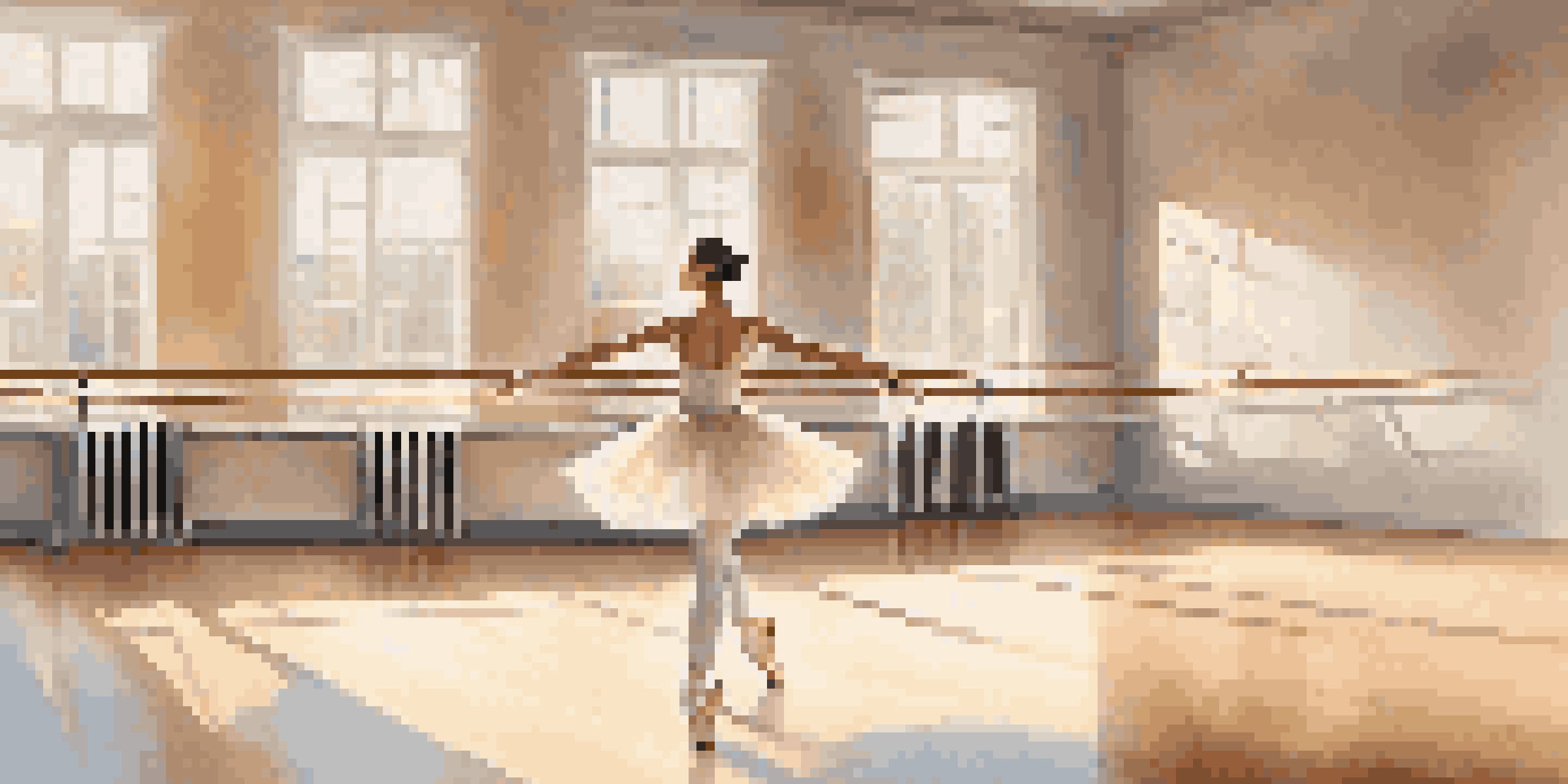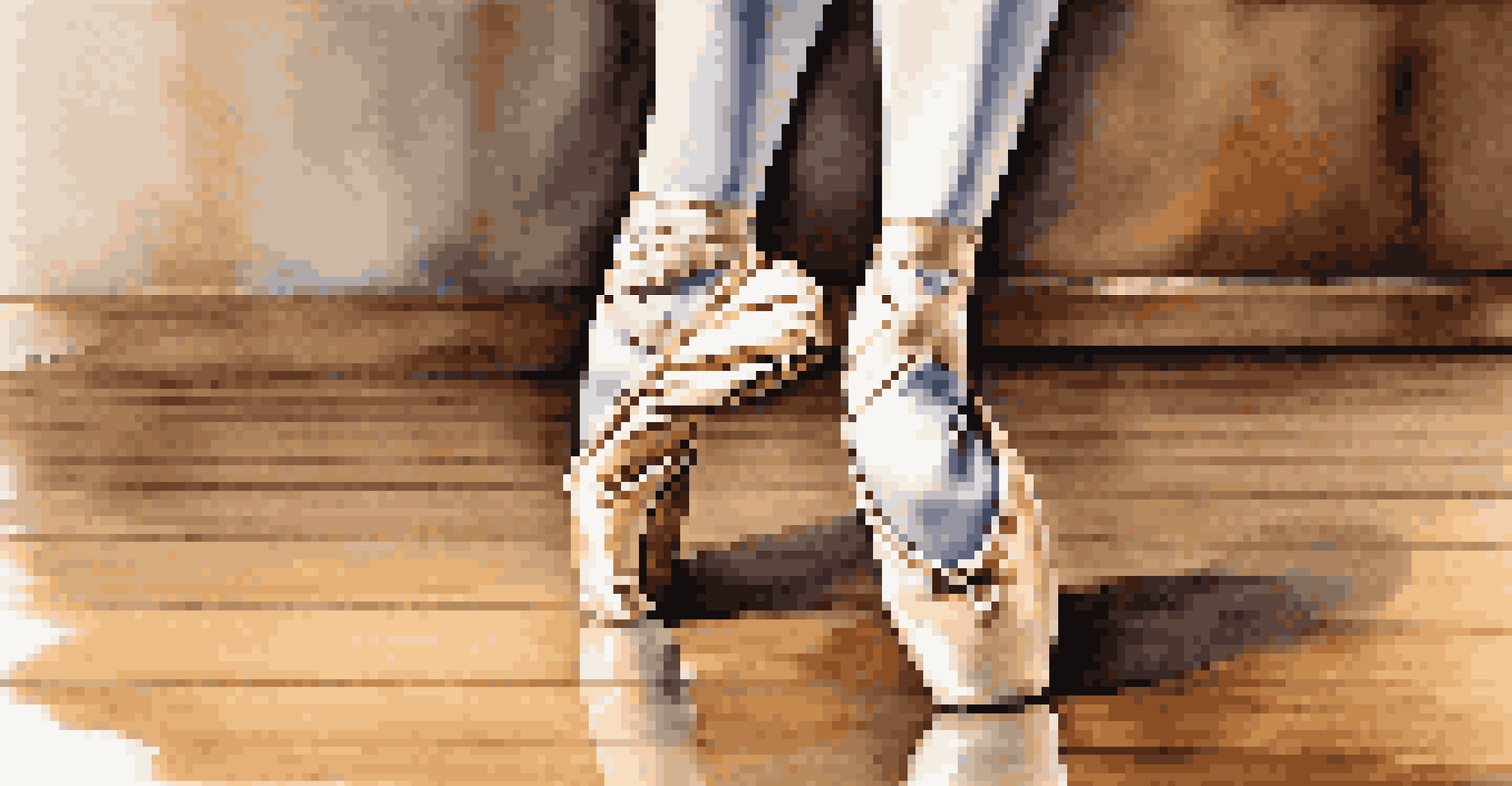Anxiety Management Techniques Used by Professional Dancers

Understanding Anxiety in the Dance World
Anxiety is a common experience for dancers, especially when preparing for performances. The pressure to deliver a flawless routine can lead to overwhelming feelings of stress and self-doubt. Recognizing that anxiety is a natural response can help dancers acknowledge their feelings without judgment.
Dance is the hidden language of the soul.
In high-stakes situations, such as auditions or competitions, the fear of not meeting expectations can amplify anxiety. This pressure often stems from both internal and external sources, making it crucial for dancers to develop effective coping strategies. By understanding the root causes of their anxiety, dancers can better manage their responses.
Moreover, anxiety can manifest physically, affecting a dancer’s performance and overall well-being. Symptoms may include muscle tension, rapid heartbeat, or even a mental block during a routine. By addressing these symptoms early on, dancers can create a healthier mindset that fosters confidence and focus.
Breathing Techniques for Calmness
One of the most effective tools for managing anxiety is controlled breathing. Dancers often use techniques like deep belly breathing to calm their minds and bodies before stepping onto the stage. This simple practice can lower heart rates and promote a sense of relaxation.

For instance, the 4-7-8 breathing method encourages inhaling for four seconds, holding for seven, and exhaling for eight. This rhythmic pattern not only reduces anxiety but also provides a moment of mindfulness, helping dancers center their thoughts. Incorporating this practice into their warm-up routine can be transformative.
Anxiety is Common in Dance
Dancers often experience anxiety due to performance pressures, making it essential to recognize and address these feelings.
Additionally, focusing on breath can serve as a grounding technique during performances. When anxiety strikes mid-performance, returning to a steady breathing pattern can help dancers regain their composure. This practice empowers dancers to take control in moments of high pressure.
Visualization Techniques for Success
Visualization, or mental imagery, is another powerful technique used by professional dancers to combat anxiety. By picturing themselves executing their routines flawlessly, dancers can build confidence and reduce performance anxiety. This mental rehearsal creates a sense of familiarity with the performance.
The only way to do great work is to love what you do.
Dancers often spend time before a performance visualizing every movement, including the emotions they wish to convey. This process not only prepares them physically but also mentally, allowing them to approach their routines with a positive mindset. The more vivid and detailed the imagery, the more effective it becomes.
Moreover, visualization can help dancers anticipate potential challenges, such as difficult transitions or tricky choreography. By mentally navigating these hurdles, they can develop strategies to overcome them. This proactive approach can significantly lessen anxiety on the big day.
Mindfulness Practices for Focus
Mindfulness has gained traction in various fields, including dance as a way to manage anxiety. This practice involves being present in the moment and fully engaging with one's thoughts and feelings without judgment. Dancers often incorporate mindfulness techniques to enhance their focus and reduce performance stress.
For instance, taking a few moments to tune into their body and surroundings can help dancers connect with their emotions. Techniques such as scanning the body for tension or focusing on the sensations of movement can ground dancers and promote relaxation. This awareness can significantly contribute to their overall performance.
Breathing Techniques Help Calm
Controlled breathing practices, like the 4-7-8 method, can effectively reduce anxiety and promote relaxation for dancers.
Moreover, regular mindfulness practice, such as meditation or yoga, can create a habit of calmness. As dancers learn to embrace stillness, they become more adept at handling the pressures of performance. This resilience allows them to approach challenges with a clear mind.
Physical Exercise for Stress Relief
Physical exercise is not only essential for a dancer's craft but also serves as a significant outlet for stress relief. Engaging in regular physical activity can release endorphins, which are natural mood lifters. For dancers, this can mean adding supplemental workouts or cross-training to their routine.
Activities such as running, swimming, or even yoga can help dancers release pent-up energy and tension. These exercises not only improve physical fitness but also provide a mental break from the demands of dance. Finding a fun and enjoyable way to exercise can make this stress relief even more effective.
Additionally, incorporating strength training can enhance a dancer's overall performance while also boosting their confidence. As dancers feel stronger and more capable, their anxiety levels may decrease. This holistic approach to fitness and mental health can lead to improved performance outcomes.
Support Systems and Communication
Building a strong support system is crucial for dancers dealing with anxiety. Connecting with fellow dancers, instructors, or mentors can create a safe space for sharing feelings and experiences. Open communication fosters understanding and can alleviate the burden of anxiety.
For many dancers, talking about their struggles can be a significant first step toward managing their anxiety. Whether it's through group discussions or one-on-one conversations, these connections can help dancers realize they are not alone in their experiences. This sense of community can be incredibly reassuring.
Support Systems Are Vital
Building a strong support system and communicating with others can significantly alleviate anxiety for dancers.
Moreover, seeking professional help, such as therapy or counseling, can provide additional tools for managing anxiety. Many dancers find that speaking with a mental health professional equips them with coping strategies tailored to their unique needs. This proactive approach can be instrumental in fostering long-term resilience.
Setting Realistic Goals for Performance
Setting realistic goals is an essential aspect of managing anxiety for dancers. By establishing achievable objectives, dancers can focus on personal growth rather than external pressures. This shift in mindset can help reduce the fear of failure and build confidence.
For example, instead of aiming for perfection, dancers can focus on mastering specific movements or improving their technique. This approach encourages incremental progress and celebrates small victories along the way. By recognizing their achievements, dancers can cultivate a more positive relationship with their craft.

Additionally, breaking down larger goals into smaller, manageable tasks can make the journey feel less daunting. This method not only alleviates anxiety but also provides a sense of accomplishment as dancers reach each milestone. Over time, these small steps can lead to significant improvements in performance.
The Importance of Self-Care Practices
Self-care is a vital component of anxiety management for dancers. Taking time for oneself can significantly impact mental health and overall well-being. Dancers often benefit from engaging in activities that promote relaxation, such as reading, spending time in nature, or enjoying a warm bath.
Establishing a self-care routine can help dancers recharge physically and mentally. Activities like journaling or practicing gratitude can also foster a positive mindset, allowing dancers to reflect on their experiences. This mindful approach to self-care can reduce feelings of anxiety and enhance resilience.
Furthermore, prioritizing rest and recovery is essential for maintaining a healthy balance. Overworking the body can lead to burnout, which may exacerbate anxiety. By listening to their bodies and allowing for adequate recovery time, dancers can ensure they are mentally and physically prepared for performances.